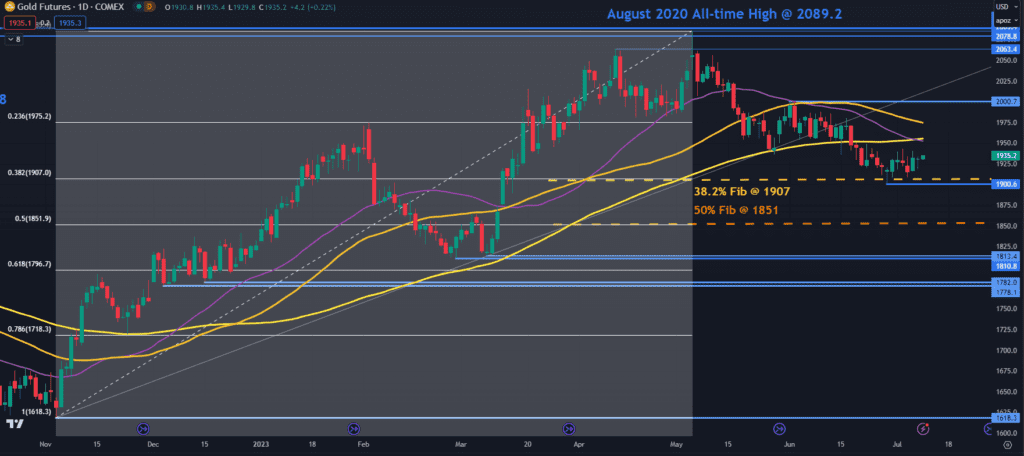Gold Price Steadies as the US Dollar experiences a downward trend and Treasury yields retreat. Investors are closely monitoring these developments to gauge the future direction of XAU/USD. Amidst shifting market dynamics and upcoming events, such as the US CPI release, it’s crucial to assess the factors influencing gold’s stability and potential price movements.
Gold, denoted as XAU/USD in the forex market, has demonstrated remarkable stability amidst the ongoing downward pressure faced by the US Dollar. Despite the Federal Reserve’s indications of potential interest rate hikes as the gold price steadies. In fact, the Asian session witnessed modest gains in gold prices as market participants absorbed the Fed’s comments and observed the decline in Treasury yields.
Gold Price Steadies Despite Market Volatility Ahead
The Federal Reserve’s notable figures, including Vice Chair for Supervision Michael Barr, Cleveland Federal Reserve President Loretta Mester, and San Francisco Federal Reserve President Mary Daly, have emphasized the importance of implementing tighter monetary policies. However, their statements diverged in terms of recognizing the work that still lies ahead and the likelihood of additional rate hikes. Atlanta Federal Reserve President Raphael Bostic adopted a more measured approach, acknowledging the restrictive stance of the central bank.
At present, market sentiment is predominantly fixated on the release of the US Consumer Price Index (CPI) data scheduled for Wednesday. The outcome of this report carries the potential to introduce heightened volatility to the market, thereby influencing the trajectory of XAU/USD. Should the US CPI numbers turn out to be softer than anticipated, concerns surrounding an aggressive stance by the Federal Reserve during the upcoming July 26th Federal Open Market Committee (FOMC) meeting may diminish.
The retreat in Treasury yields, which had reached their peak levels last week, has contributed to the weakening of the US Dollar. The benchmark 10-year note has dipped below the 4% mark, further accentuating the depreciation of the US Dollar. Concurrently, the Japanese Yen has gained strength against its US counterpart, with USD/JPY descending from levels above 145 observed at the end of June to below 141. These fluctuations within the currency market possess significant implications for the dynamics of XAU/USD, warranting careful observation by traders and investors alike.
Crude oil prices have shown stability throughout the Asian session, with the WTI futures contract maintaining a position around US$73.50 per barrel, while the Brent contract remains slightly above US$78 per barrel. This steady performance in crude oil prices holds the potential for a spillover effect on the gold market. The correlation arises from crude oil’s influence on inflationary expectations and overall market sentiment. As crude oil prices stabilize, it can impact investors’ perceptions of inflation and economic stability, subsequently influencing their demand for safe-haven assets like gold.
Click here to view the Live Crude Oil Price Chart
In addition to the influence of crude oil, the performance of equities in the Asia-Pacific (APAC) region is also a factor to consider. Notably, Hong Kong’s Hang Seng Index (HSI) and South Korea’s KOSDAQ index have displayed positive performance, leading the way among APAC markets. The strength exhibited by these markets can significantly impact investors’ risk appetite and subsequently influence the demand for safe-haven assets like gold. As equities in the APAC region continue to perform well, it may temper the demand for gold as a safe-haven asset, potentially impacting XAU/USD.
Click here to view the Live Gold Price Chart
Looking ahead, several key events are anticipated to generate market movement and potentially impact XAU/USD. First, the release of UK jobs data will provide insights into the labor market’s health and potentially influence market sentiment. Additionally, German Consumer Price Index (CPI) data and the ZEW survey will shed light on the state of inflation and economic sentiment in the Eurozone, which can have implications for gold prices. Moreover, the Reserve Bank of New Zealand (RBNZ) will announce its decision on the cash rate, a critical factor that can shape global currency flows and subsequently impact the performance of gold. As market participants digest these events and their implications, XAU/USD may experience heightened volatility and potential shifts in its trajectory.
From a technical standpoint, the gold price seems to be establishing a new trading range between 1900 and 2000 over the past two months. Potential support levels can be found at the Fibonacci Retracement levels of the move from 1618 up to 2085, with the 38.2% retracement level at 1907 and the 50% level at 1851. The recent low at 1900 may also provide some support. On the upside, resistance could be encountered in the 1950 – 1975 area, where the 34-, 55-, and 100-day simple moving averages (SMA) converge. The peak of 2000 may act as additional resistance, potentially followed by a resistance zone in the 2060 – 2090 area.

Conclusion
As gold steadies amid the weakening US Dollar and declining Treasury yields, the market awaits the US CPI data for potential market volatility. The mixed signals from the Federal Reserve and the upcoming events, including the RBNZ rate decision, UK jobs data, and German CPI, will likely shape the future path of XAU/USD. Traders and investors must stay vigilant and monitor these factors closely to make informed decisions and navigate the evolving gold market.
Click here to read our latest article on Central Banks Worldwide Driving the Digital Currency Revolution


